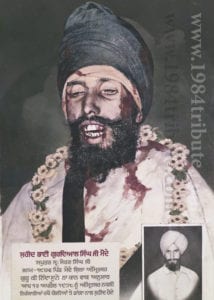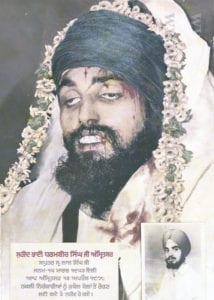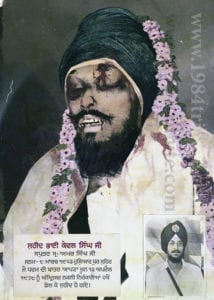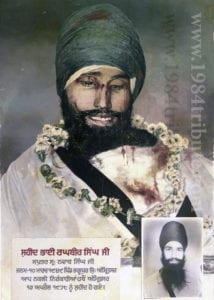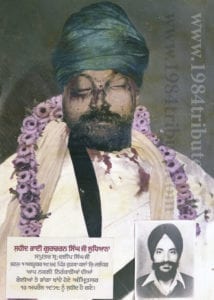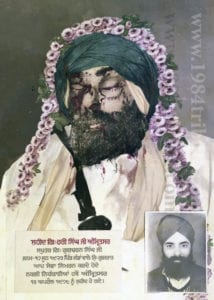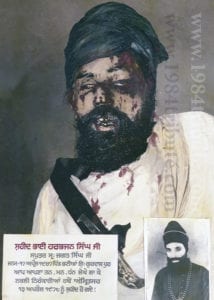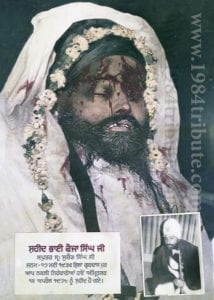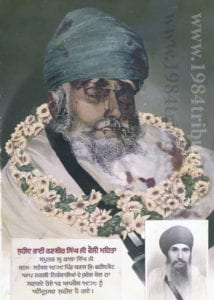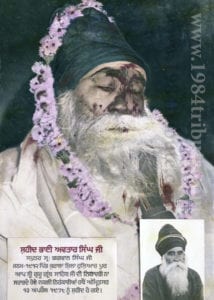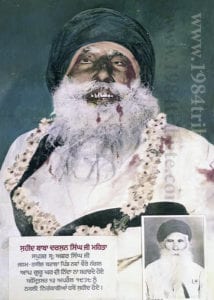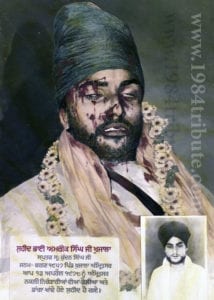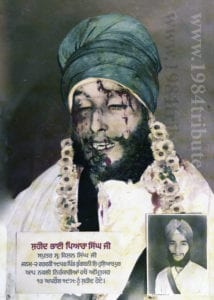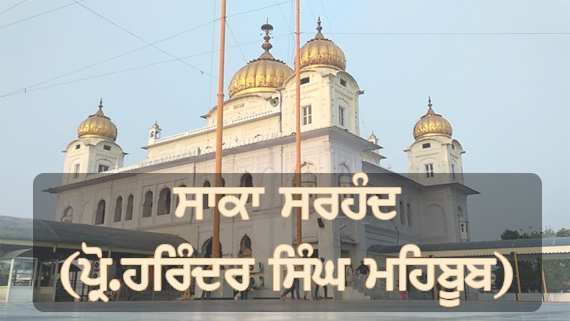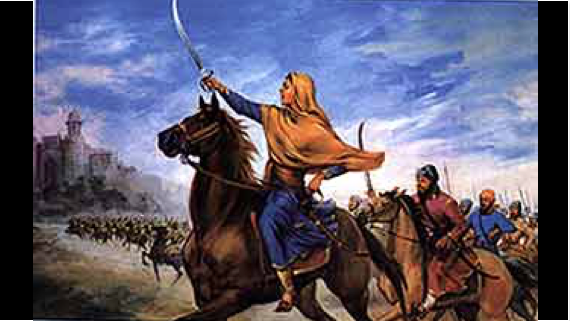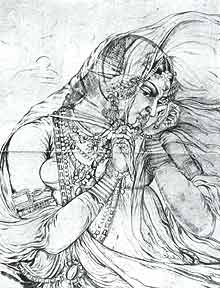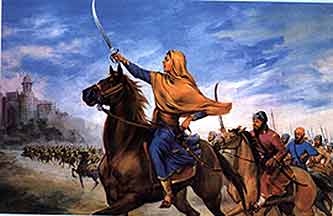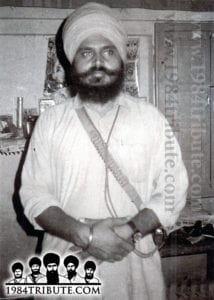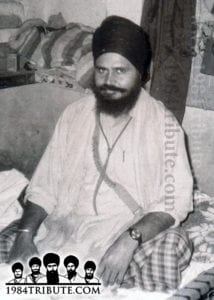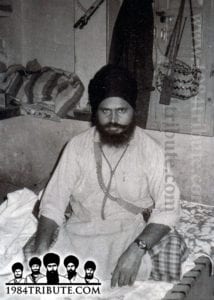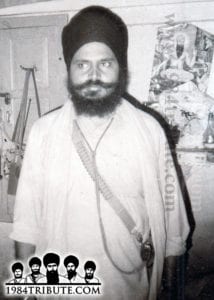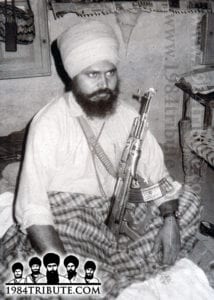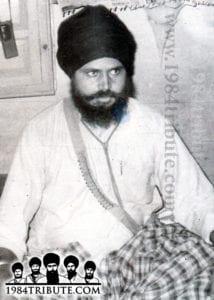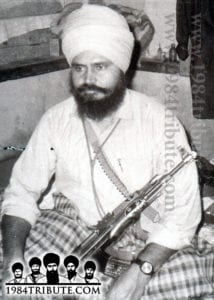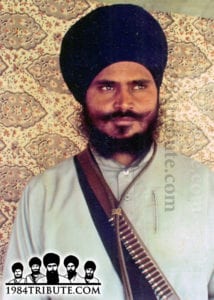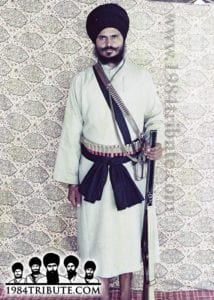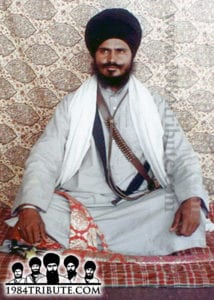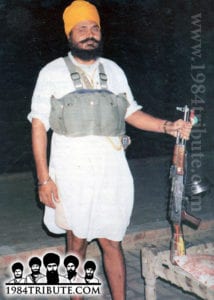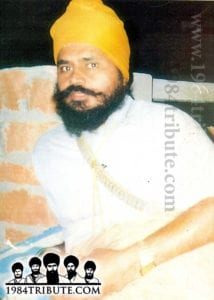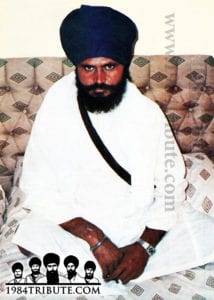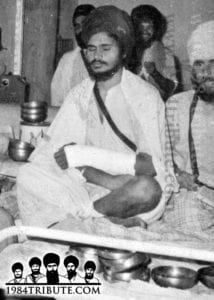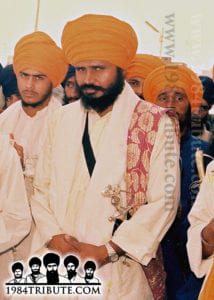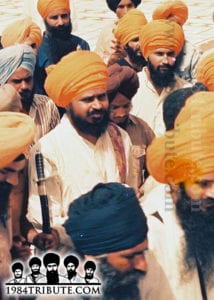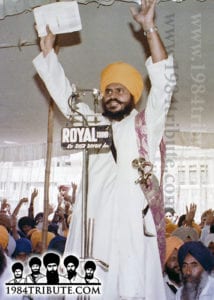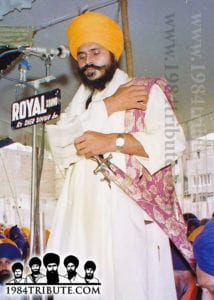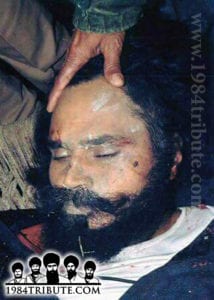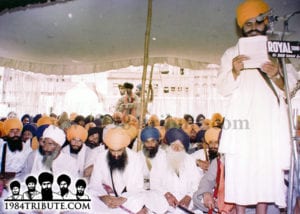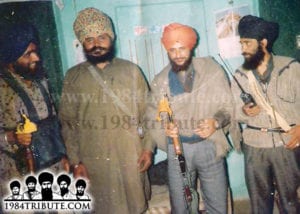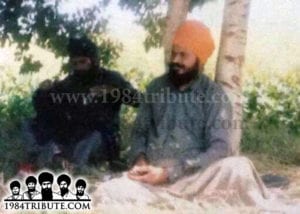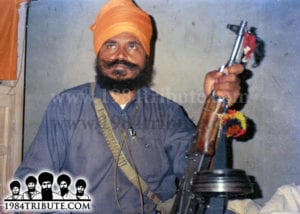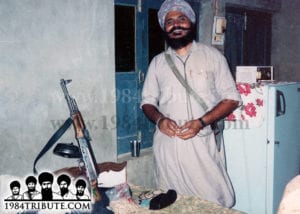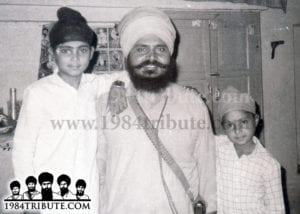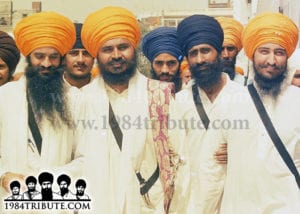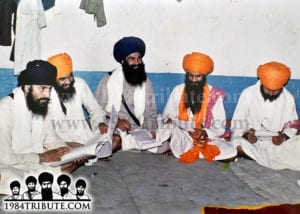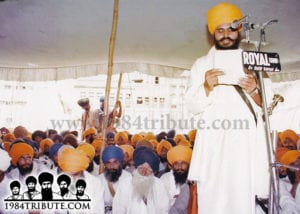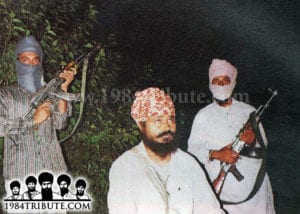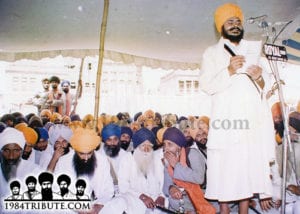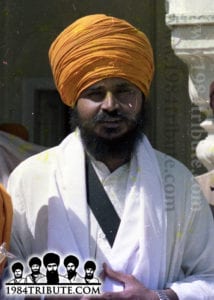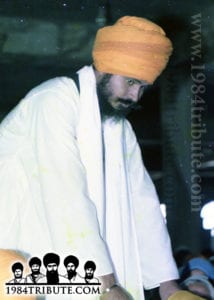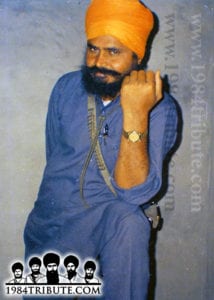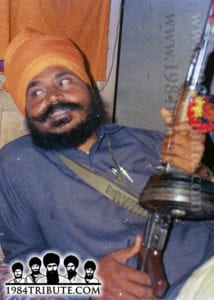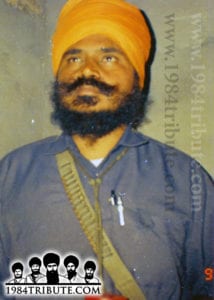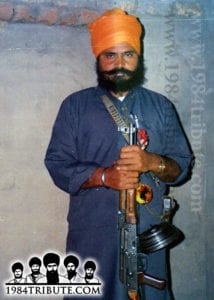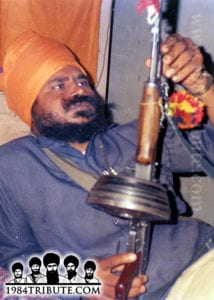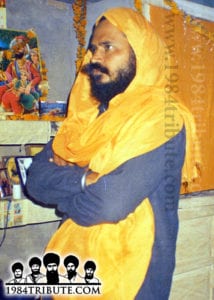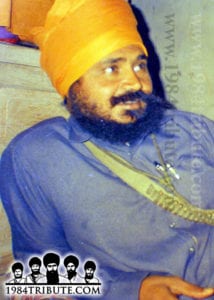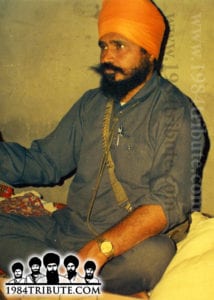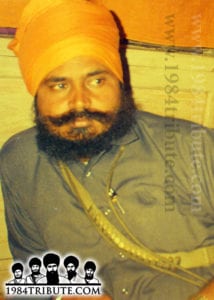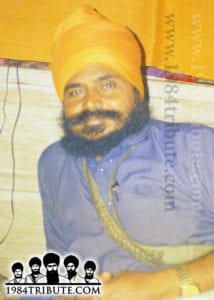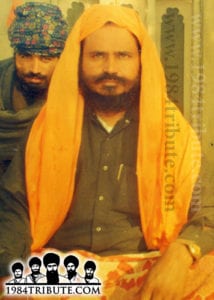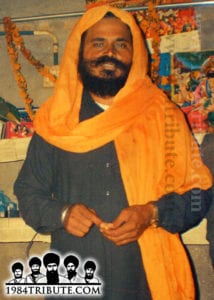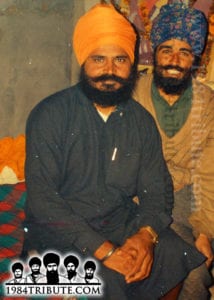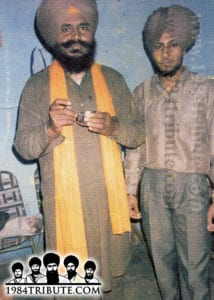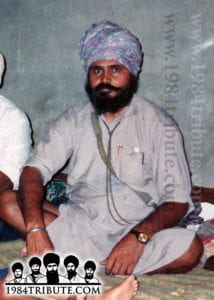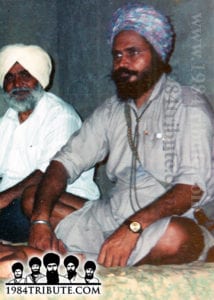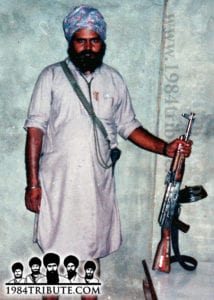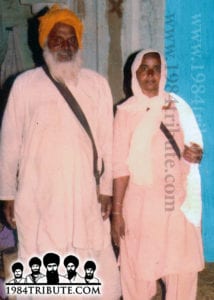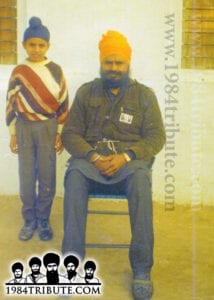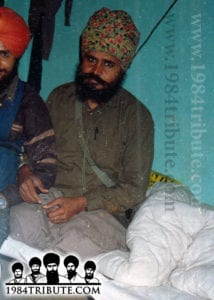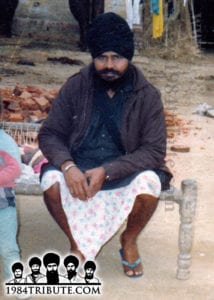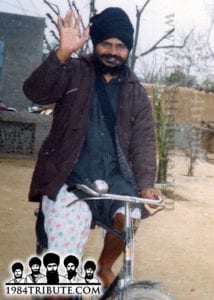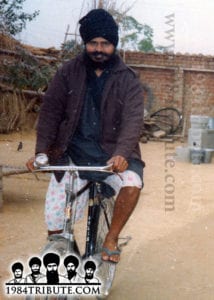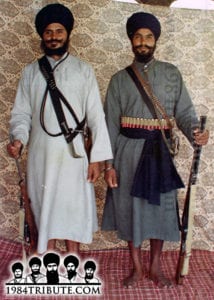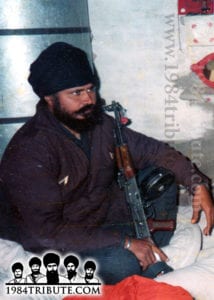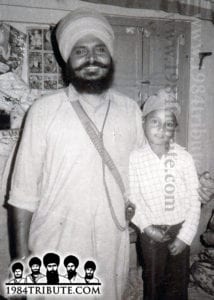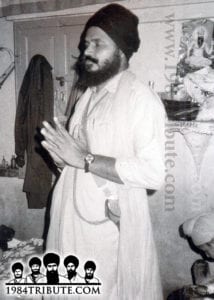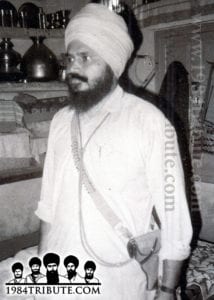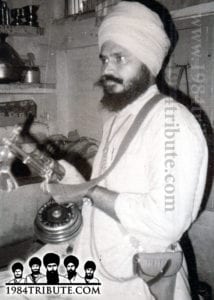Bhindranwale Tigers Force of Khalistan
Baba Gurbachan Singh was the last major Sikh Resistance leader to fall. The Indian Government had put a RS 25 lakh reward on his head and was searching the entire Tarn Taran area for him, conducting 45 raids at one time to trap him. Baba Ji escaped each time and continued to be a painful thorn in India’s side. When all the other Singhs had been martyred and the entire Indian Security Force was on his trail, he refused the order to go and hide in Pakistan and spit on the offer to surrender. He simply could not be caught. Even in the end, he was martyred not by police bullets, but by the betrayal of those he considered his own.
Baba Ji was a Sant Sipahi and a farsighted General. In honour of Baba Ji’s 12th Shaheedi anniversary falling on February 28, I will be posting the story of this Sikh hero as well as stories about his time in the struggle.
Birth
Baba Gurbachan Singh Manochahal was born on June 6, 1954 at village Manochahal in Amritsar district. His parents were Bapu Atma Singh and Mata Gurmej Kaur. His parents were simple farmers but their family had a heritage of struggle against injustice. Bapu Atma Singh’s uncle had become shaheed in the Jaito Morcha, marching against the British Raj. Baba Gurbachan Singh was from childhood a very strong and muscular boy. He enjoyed wrestling and other sports. The family moved from village Manochahal to Nausherae Panooaa(n) when Baba Ji was still young because his mother’s brothers had left for Singapore and left behind a large farm that had to be maintained.
Becoming a Baba
Baba Ji was in the tenth grade when once he saw a boy inappropriately teasing and harassing a group of girls. Baba Ji grabbed the troublemaker and beat him badly. The teacher found out and in front of the entire class asked the young Gurbachan Singh to explain why he had beaten the other boy. Baba Ji explained, “Sir, he was harassing the bibis and after all, all women should be like our sisters. So, I couldn’t help myself and I did what I had to.” The entire class began to laugh at Gurbachan Singh’s use of the word “bibis” for the schoolgirls. The teacher laughed and said, “I see! These girls are “bibis” and you would be the “Baba Ji.” All students! From now on, everyone will call Gurbachan Singh, Baba Ji!” After that day, the nickname “Baba” stuck and everyone began to call him Baba Gurbachan Singh. In the entire area, people began to know him as “Baba Ji.”
Days in the Army
Baba Gurbachan Singh completed his education and at his father’s wishes, decided to join the army. Baba jee was 6”1 and over 200 pounds. The army happily enlisted him as an “A level” recruit. Even in the army, the name “Baba” Gurbachan Singh stuck. He was known for doing paath and being a devoted Sikh, even though he was not yet Amritdhari. Every day he dedicatedly did his nitnem. One day, as Baba Ji was doing nitnem, he fell into deep Samadhi (meditation). The time for the daily military parade came and went and Baba jee had no awareness of it. The officer in charge of the parade demanded to know where Baba Gurbachan Singh was. The other soldier tried to explain that he was meditating but the Hindu Officer had a bias against Sikhs and refused to understand.
The officer went to Baba Ji and shook him into awareness. Baba jee apologized for missing the parade and explained he was reciting Gurbani. The officer responded by making fun of the Sikh faith and insulting the Gurus. Baba Ji’s anger couldn’t be controlled and he tackled the officer. His fists flew and the officer shrieked for someone to help him. The other Sikh soldiers watching did nothing as they knew how much the officer hated Sikhs. The beating continued for some time when finally other officers came and stopped Baba jee. Baba jee had broken the Hindu officer’s arm and his nose. Baba Gurbachan Singh was arrested and court marshalled. After a year of prison, Baba Ji left the army and returned home with a desire to dedicate his life to Sikhi.
Meeting Sant Kartar Singh Bhindranwale
Although Baba Gurbachan Singh did nitnem and had a love for Sikhi, he was still not Amritdhari. Baba Ji always attended programs by various Sants and one day he found out that Sant Kartar Singh Bhindranwale would be coming to his village for a program. Baba Ji was very moved by the katha and wanted to speak with Sant Kartar Singh. Sant Kartar Singh Ji Bhindranwale encouraged him to become Amritdhari and so Baba Ji did so within just a few days. After receiving the gift of amrit, Baba Gurbachan Singh decided to travel with Jatha Bhindran. He became very close to Sant Kartar Singh and also learned Gurbani Santhaya and Katha. Baba Ji had memorized many banis and had a very long daily nitnem which he began very early at amrit vela. After the passing of Sant Kartar Singh Ji Bhindranwale, Sant Jarnail Singh Ji Bhindranwale became the next Jathedar of the Jatha and Baba Ji was also very close to him.
1978 and After
In the 1970s, the Indian government sponsored Nirankari cult began to come to the forefront and publicly derided the Sikh faith and insulted the Sikh Gurus. The cult chief, Gurbachana was known to have said insulting things like “Guru Gobind Singh made the Panj Pyare, I’ll make the sat sitaray”. He also insulted Guru Granth Sahib.
On April 13, 1978, the Nirankaris had a march through Amritsar in which slogans against the Sikh religion were shouted. Singhs from the Akhand Kirtani Jatha and Jatha Bhindran marched peacefully against the Nirankaris but were brutally attacked. 13 Singhs were martyred and many more were injured. Baba Gurbachan Singh had also taken part in this protest and was shot in the arm. When the Nirankaris continued with their insulting parchar and were protected by the Indian Government, the Singhs began to punish the Nirankaris themselves and Baba Gurbachan Singh also wanted to join this movement. When he asked Sant Jarnail Singh for permission, Sant Ji kept saying that Guru Sahib was to take a very big sewa from him yet. Sant Jarnail Singh asked Baba Gurbachan Singh to return to his village of Nausherae Panooaa(n) and direct the building of Gurdwara Baba Dhanna Singh Kaviraj there. Baba Ji accepted this hukam and returned to his village, but visited Sant Jarnail Singh Ji Bhindranwale regularly even after.
Sant Jarnail Singh Bhindranwale & Baba Ji
Baba Gurbachan Singh Manochahal’s relationship with Sant Jarnail Singh was very close. Once, someone in Nausherae Panooaa(n) made the accusation that Baba Gurbachan Singh didn’t even know Sant Jarnail Singh and was using his name for his own purposes. Baba Ji gathered the Sangat and travelled to Amritsar to disprove this allegation. Baba Ji and the Sangat went to the roof of Guru Ram Das Langar and when Baba Ji told Sant Jarnail Singh about what had been said, Sant Ji replied, “Gurbachan Singh is so near to me that he can cut off my head and take it away if he wants.”
When in 1982, Sant Jarnail Singh Bhindranwale had gone to Bombay, the Indian Government thought it was the perfect time to capture him. The police surrounded the area and when Sant Ji received word of this he thought of a clever ruse. Baba Gurbachan Singh, who had been travelling with the Jatha, was about the same height as Sant Ji and wore the same style of clothes. He covered his face and lay down in Sant Ji’s bed so those watching would be fooled. Until Sant Ji had made his escape, Baba Gurbachan Singh continued to lie in bed and when he finally got up, the government agents were shocked and disappointed that their opportunity to arrest Sant Ji had passed.
Later when Baba Gurbachan Singh would volunteer for different missions to punish the enemies of the Panth like Bhajan Lal and various police officers, Sant Jarnail Singh would always say, “These are all small jobs for you. I am going to take a very big sewa from you eventually.”
The Gurdwara in Nausherae Panooaa(n) where Baba Ji did sewa was regularly visited by Singhs serving in the Movement.
1984
As the days of the attack seemed to be drawing nearer, Sant Jarnail Singh Bhindranwale sent a message to Baba Gurbachan Singh for him to come meet him at Sri Darbar Sahib. Baba Gurbachan Singh was waiting for the opportunity. Sant Ji met Baba Ji very warmly and told him that an attack on Sri Darbar Sahib was imminent. Baba Ji requested that finally this time his sewa should be accepted and he would join Singhs in defending the Complex and become Shaheed. But Sant Ji knew that this Singh would one day be a General that would shake all of India. Sant Ji said that not all the Singhs should be Shaheed in the attack. That after the attack the struggle must continue and it would no longer be a struggle for greater water rights or concessions from the Centre, it would only be for independence, for Khalsa Raj. Baba Ji vowed to give his all in the fight for the Panth and for sovereignty. Sant Jarnail Singh gave Baba Gurbachan Singh a Saropa and lovingly ordered him to return to his village and not return until summoned. Baba Ji knew this would be their final meeting.
The attack took place and the Singhs defending Darbar Sahib became Shaheed after wreaking havoc on the Indian Army. Baba Gurbachan Singh knew that the “Big sewa” Sant Ji had spoken of was now at hand. Even before the 1984 attack, Baba Gurbachan Singh was a wanted man. The security forces knew he was close to Sant Jarnail Singh Bhindranwale and was committed to the Sikh nation. As early as 1980 the police had once surrounded Gurdwara Baba Dhanna Singh in Nausherae Panooaa(n) where Baba Ji was doing sewa and ordered Baba Ji to surrender. Baba Ji told the police party that he would change his clothes first. He went inside his room and came out with a big kirpan. Taking it out of its sheath, Baba Ji bellowed, “Whoever has got the courage can come and arrest me.” The police party was terrified and no one approached. By this time the village Sangat had also assembled and the Police were forced to return to their stations empty-handed. In 1981 Baba Ji had begun to carry a revolver and knew that the Sikh struggle would have to resort to arms.
June 1984 & After
Baba Ji’s heart was breaking when news of the attack on Darbar Sahib arrived. He was wishing that he too could join his fellow Singhs in defence but he was bound by Sant Jarnail Singh Ji’s orders. He knew Sant Ji wanted him to organize the Sikh Freedom movement after the attack.
When villagers began to march towards Sri Darbar Sahib Baba Ji understood their pain, but knew this would be fruitless. Thousands of Sikhs had risen up from the villages and had been mowed down by the army. Baba Ji sent messages everywhere that marching on Amritsar without any weapons was useless. They should wait for weapons and then together, with a set strategy, they would fight the government. In this way Baba Gurbachan Singh saved many lives and laid the foundation for the future movement.
No Compromise
After the attack, those Singhs who were close to Sant Jarnail Singh and were ready to take on the government began to have secret meetings. Reporter Dalbir Singh was a well-educated journalist who knew Sant Jarnail Singh very well. He gathered with the remaining Singhs like Manbir Singh Chaheru (General, Khalistan Commando Force) and others and told them that a fight for Khalistan would not be useful. He said that there were not enough Singhs to fight and the Indian government had a security force that could not be defeated so easily. The other Singhs began to discuss with Dalbir Singh about what could be done. When Baba Manochahal was asked for his opinion, he said plainly, “Paji, the government and its agents have oppressed the Sikhs. They’ve dishonoured our mothers and sisters. We are going to take justice for that. Regarding all these political issues you’re talking about, you can deal with them as you see fit.” There was no discussion left. Baba Ji was determined to keep his promise of fighting for Sikh freedom.
Early Battles
Through 1985, Baba Gurbachan Singh began to organize the Singhs to fight against Indian oppression. He made speeches and created popular support for an armed movement.
The police were on Baba Ji’s trail and once even managed to capture him. The CRPF (Central Reserve Police Force) had sideswiped Baba Ji’s motorcycle one night and then after tying him, threw him in their jeep. Baba Ji managed to untie himself and after pushing his captors, jumped from the moving jeep. He ran through the fields and managed to escape.
This was just the beginning. Baba Ji’s true life as an outlaw would begin after a battle in his own home village Manochahal. Baba Ji had gone to meet his family and was to spend the night in a small hut in the fields when someone informed the police. Baba Ji and his brother Bhai Mahinder Singh were asleep when the police party surrounded the hut. The head of the police party knocked on the door and shouted for Baba Manochahal to surrender. Baba Manochahal knew that the situation was dire and decided to buy some time. He demanded that the village head (sarpanch) be summoned and only then would he come out. The police brought the sarpanch and when the sarpanch went to speak with Baba Gurbachan Singh, he tried to explain that the hut was completely surrounded. The Police again demanded that Baba Ji open the door. The sarpanch was asked to stand aside. Baba Ji then yelled from inside, “Give me a flashlight!” The police were confused and asked “Why do you need it?” Baba Ji replied, “We’ve locked the door from the inside and need it so we can see the lock!” The police passed a torch through the space under the door. Baba Ji and his brother armed their assault rifles and set them on “burst”. Baba Ji threw open the door and began to fire. The CRPF officer at the door fell immediately and the others also came under fire. The Bihari officers began to run in all directions, screaming “Run! They’re going to kill us!” Baba Ji and his brother jumped over the officers who were still lying in position. A Punjab Police officer tried to tackle Baba Ji as he was running but also failed. Baba Ji had wreaked havoc on the police and escaped. One officer thought Baba Ji was chasing him and for 3 kilometres ran in front of Baba Ji. Baba Gurbachan Singh did not harm the poor police officer and let him go.
Panthic Committee & The Bhindranwale Tigers Force
By 1986, the Sikh Freedom movement had begun and a five member Panthic Committee was formed to give the movement direction. The Singhs choosing the Committee were all affiliated with Damdami Taksal and had chosen five Singhs also affiliated with Taksal. Baba Gurbachan Singh requested that at least one Singh from Babbar Khalsa be chosen and he would give up his own spot if needed. The other Singhs did not agree and the Committee was announced. Baba Gurbachan Singh felt that without including all members of the struggle, regardless of their Jathebandi, the Committee would not accomplish all it would have, but he continued on as a member.
A Sarbat Khalsa was called on January 26, 1986 in which the Panthic Committee was announced to the Sikh Panth. The five members were Baba Gurbachan Singh Manochahal, Wassan Singh Zaffarwal, Bhai Dhanna Singh, Bhai Aroor Singh and Bhai Gurdev Singh Osmanwala, Bhai Gurdev Singh Kaunke was appointed acting Jathedar of Sri Akal Takhat Sahib. The Sarkar Takhat that was built by the Indian Government to stand in place of the destroyed Sri Akaal Takhat Sahib was also ordered to be destroyed. The kar sewa of the new Sri Akal Takhat building began that day.
On April 29, 1986 the Panthic Committee called a press conference at Sri Darbar Sahib and made the declaration of an independent Sikh nation, Khalistan.
Baba Gurbachan Singh along with the other Singhs had gone into Darbar Sahib undercover. Baba Ji tied his beard and took on the appearance of a lawyer, complete with briefcase. On April 30, Bhai Gurdev Singh was arrested and Baba Gurbachan Singh was appointed acting Jathedar of Sri Akal Takhat Sahib. In the period that followed it was always confusing who was Jathedar as this position changed quite frequently. Baba Ji was once again appointed Jathedar on October 23, 1987. It was at this time that Baba Gurbachan Singh emerged as head of a new organization: The Bhindranwale Tigers Force of Khalistan (BTFK). Some top lieutenants who worked with Baba Ji were Bhai Sukhwinder Singh Sangha, Bhai Satnam Singh Sheena and Bhai Surjeet Singh Behla. Baba Ji’s brother Bhai Mahinder Singh also was a close associate.
Trip to Pakistan & Tragedy
Baba Manochahal decided to make a trip to Pakistan to secure arms for the Singhs. In his absence, he appointed Bhai Mahinder Singh to supervise operations. When arms arrived, Bhai Mahinder Singh and Bhai Sukhwinder Singh had a disagreement about the distribution and both parted company. The touts of the Indian Government decided to make use of this disagreement. They tricked some Singhs working under Bhai Sangha into shooting Bhai Mahinder Singh. They were told he was a goon and terrorizing the common people. Without checking on whom they were attacking, the foolish recruits ended up shooting Bhai Mahinder Singh. Baba Gurbachan Singh returned to Punjab to find out what had happened and many Singhs blamed Bhai Sangha for the death and asked that Baba Ji take revenge. Baba Ji asked for an explanation from Bhai Sukhwinder Singh and then after hearing the story simply said, “What’s done is done. In the future be sure about whom it is you’re going to shoot.” The Singhs in the Jathebandi were shocked that Baba Ji would let his brother’s death go unpunished but Baba Ji insisted that the mission was Khalistan and to get caught in small personal battles was self-defeating. Bhai Sangha eventually left the Majha area and operated out of Malwa independent of Baba Ji. When eventually Bhai Sangha was martyred, Baba Gurbachan Singh expressed his sadness and when others Singhs pointed out that Sangha had left the Jathebandi, Baba Ji said, “our goal was the same. Everyone makes mistakes and we should over look them.”
Daily Routine and Rehit
In the early days of the movement, Baba Gurbachan Singh kept a hideout in the swamps of the Mand area. Here he set up some huts and also a separate hut for Guru Granth Sahib. Baba Ji would sleep on the floor and every day wake up at amrit vela and do two hours of naam abhiyaas. After, he would complete his very long nitnem and do sehaj paath from Guru Granth Sahib. Baba Ji daily completed five Sukhmani Sahibs even in the thick of battle.
After his morning paath Baba Ji would read up to seven different newspapers to keep aware of events and government propaganda. He would plan strategic strikes that would weaken India’s hold on Punjab and break the occupier’s confidence. During this time, Baba Ji even had amrit Sanchars at this small dera for those who wanted to become Khalsa.
Baba Ji & the Pirs
If anyone has been to Punjab they will see that at every half kilometre, there is the grave of a Muslim Pir (saint). These graves are often not even real and made just to make money. Ignorant Hindus and Sikhs even worship these graves and when going past them, villagers are very afraid.
Once Baba Gurbachan Singh and another Singh were passing the grave of “Gainda Shah”. The Singh with Baba Ji stopped at the grave and because of fear, offered his respects. Baba Ji stood afar and watched all this. When the Singh was finished, Baba Ji took off his shoe, walked to the grave and began to hit it. The other Singh was terrified and shocked. But when nothing happened, Baba Ji walked away without a word, that Singh and other villagers watching understood that the graves had no power. In Nausherae Panooaa (n), there is a grave of a Pir that is considered holy by mothers with sons. They give their sons first pay to those looking after the grave. Baba Ji’s mother also once went to the grave and offered prayers for Baba Ji’s protection and gave Rs. 500. Baba Ji found out about this. When he went home to visit his family one night after his return from Pakistan, his sister-in-law asked, “Do Muslims also come to matha tekh at Nankana Sahib?” Baba Ji angrily replied, “Muslims aren’t idiots like you who leave their own places of worship and wander about elsewhere.” The family understood what Baba Ji was referring to.
Baba Ji used to also speak against fake Sants. One such Sant was thought to have magical powers. A Singh asked Baba Ji, “Don’t you feel afraid talking badly about that Sant? Aren’t you afraid of being cursed?” Baba Ji replied, “If Guru Gobind Singh’s Singhs start getting effected by the curses of these Saadhs, then what point is there in being a Singh? If these curses did effect us, I’d take my kirpan and give it back to Guru Sahib and ask him what was the point of being his Singh if we still have to fear fake Saadhs like that.” Baba Gurbachan Singh was becoming the head of a very powerful force and the people of Punjab were giving them all possible support. In the plains of Punjab, a guerrilla movement is almost impossible unless the people are willing to hide and shelter the fighters. Rural Punjab was almost completely under the control of the Singhs and the Indian Security Forces were afraid to even go near them.
Respect for Human Life
Baba Manochahal was respected as being one of the wisest of Generals in the movement. Baba Manochahal was very opposed to waste. When in an encounter, he would stay very calm and only fire when he was sure the bullet would be effective. He once said to Bhai Surjit Singh Behla, “In an eight hour encounter I fired a total of 150 rounds. You Singhs fire so many rounds for no reason at all.” When once some Singhs of a different group killed a police informant and his entire family, Baba Manochahal met the leader of the group and said, “If he was an informant then you should have eliminated just him. Why did you kill his children?” Baba Ji never killed a Hindu for just being a Hindu. He was completely opposed to pointless killing. In a meeting of Singhs Baba Ji explained, “A child is born and then it takes at least 18 years for him to become a man. It cannot be called humanity to mow him down based on a decision made in just a few seconds. It’s important to give people at least three chances to correct themselves.
Character Assassination
The government was becoming afraid that Punjab was slipping from their grasp. They decided to change the way in which the battle was being fought. New groups were formed under the direction of various police officers. These groups dressed like Singhs but went into villages to loot, rape and kill. After performing their disgusting deeds, they would shout Khalistan slogans and leave. The government also began to spread falsehood about Baba Manochahal that he was involved in rapes and looting and even that he had links to the government. But all these stories were false. Baba Ji always treated all women as sisters. Once the Singhs kidnapped a police officer and his wife in order to secure the release of some captured Singhs. When the police kidnapped or arrested Singhs’ women family members, they were abused with filthy language and often even raped. Baba Manochahal treated the police officer’s wife like a sister and when they couple was released, just like a brother sends away his real sister, Baba Ji gave her a new suit.
The government itself had spread the rumour that Baba Manochahal had links with Buta Singh, a Congress Minister. It said that Baba Ji was not being caught because he was staying in Buta Singh’s mansion and receiving shelter there. There was of course no truth to this. Baba Gurbachan Singh used to spend his nights in fields or families’ houses. He travelled by bicycle or by foot most often and lived a very simple life. Once it was raining and Baba Ji was sitting in a sugar cane field. He had spread a plastic sheet over top, but it was beginning to leak. A Singh came to meet him and Baba Ji laughed, “Welcome! Come and see Buta Singh’s mansion. Wipe your feet outside or you’ll muddy the rugs.”
Satwant Singh & Kehar Singh’s Bhog
Bhai Satwant Singh and Bhai Kehar Singh were hung for their involvement in the assassination of Indira Gandhi on January 6, 1989. All Sikh Resistance Movement fighters organized a common Akhand Paath Sahib in their memory. Bhai Wadhawa Singh Babbar sang the shabad “Sajan meray ranglay.” In a very moving way, all the Singhs became emotional. All the Movement leaders were present, Bhai Wadhawa Singh Babbar, Bhai Gurjant Singh Budhsinghwala, Bhai Paramjit Singh Panjwar, Bhai Charanjit Singh Channi and others.
Some attempts were being made at having unity between the different groups. But as is the case with all Sikhs, there were serious differences and the Indian government too had succeeded in some ways at creating distrust. There were whispers that perhaps Baba Manochahal really was a government agent and maybe he really did allow raping and looting. As the discussions were continuing, Baba Manochahal stood up and declared, “I, Manochahal, have been accused of a lot wrong things. I’m a government agent, I’m a looter, and I’m also friends with Buta Singh. Apparently I’ve bought a lot of land in UP (using the money of the panth) but I want to say that wherever you find this land, you can distribute it in the Panth. My fight is dedicated to Sant Jarnail Singh Bhindranwale’s words and I won’t back down from that, regardless of whether my family is finished and my children are cut to pieces in front of me. If Banda Singh Bahadur could have his child’s heart put in his mouth, why can’t I? I also tasted the same Guru’s amrit. I could be accused of anything and I wouldn’t care. All I care is that my Kalgeeaa(n) Wala is not disappointed with me and then for all I care, the entire world can be angry.”
Battle of Rataul
One of the most famous battles in the history of the modern Sikh Movement took place in village Rataul. Baba Manochahal and some companions were staying in this village when it was cordoned off by the police. One Singh was resting at the house, different to the one being used by Baba Manochahal, when the police entered. The Singh entered an underground bunker. The police became suspicious since a set of muddy foot prints could be seen leading to a corner and then mysteriously disappeared. When they went to the corner and moved a drum of flour, the entrance to the bunker became visible. Right away, the Singh inside opened fire and dropped the entire group. The cowardly Indians began to run in different directions and the Singh managed to escape from that house. Word was sent to Baba Manochahal that the village was surrounded and he should escape. Baba Ji along with his body guard broke the cordon and escaped. Inside the village, 5 Singhs gathered at a house where they had made a concrete bunker. They had decided to show the police what a real encounter was like. The army along with police divisions from Amritsar, Gurdaspur, Tarn Taran and Batala surrounded the area. The Singhs were well armed and had sniper rifles as well. A DIG of the police was trying to lead his men and give them courage to fight when the Singhs shot him dead. The loss of such a high ranking officer demoralized the already scared troops. The Singhs continued to bellow jaikaray from inside the bunker as they fought. Police officers attempted to pick up the body, but each time were forced to retreat under fire. The body lying there continued to demoralize them.
The Singhs fought for a total of 72 hours. The Security forces had lost so many men that it could no longer stand to fight anymore. They ordered a helicopter and had the bunker bombed. The five Singhs inside were all Shaheed but they showed the world that Guru Gobind Singh’s words “Sava lakh say ek laraaoo(n)” are still true.
Election Boycott
The Indian Centre ordered elections for Punjab on February 19, 1992. A group of Sikh fighters under the Panthic Committee headed by Dr. Sohan Singh ordered the Sikhs to boycott the elections. Baba Gurbachan Singh on the other hand wanted the Sikhs to take part in the elections and by electing Panthic Singhs, show that the will of the people was Khalistan. Once a Panthic government was formed in Punjab, it could pass a motion for independence and show that Khalistan was the will of the people. Even if such a government were dismissed by the Centre, the will of the people would have been expressed as being in favour of independence.
Baba Manochahal’s stand was criticized by many and Dr. Sohan Singh called him an agent of the government. Baba Ji replied, “The time will come when the Panth will know who is a government agent and who is not. But that time is unfortunately not going to come any time soon.” Dr. Sohan Singh is still alive today, walking a free man on the streets of Chandigarh. Some misguided fighters went so far as to attack Baba Ji’s family in their home. Baba Ji’s companions asked him to reply to this attack in kind but Baba Ji simply said, “If they are making a mistake, should I make a mistake just like them too? The government already wants that we should fight and kill each other. Should we help the government by fighting each other?”
Baba Ji kept encouraging the Sikh Movement leaders to not boycott the election saying that if they participated they would clearly win but if they did not, Baba Ji said, “it’s like taking off our shoe and handing it over to our enemy to beat us over the head with. Singhs! Please don’t make this mistake.” But short sightedness resulted in a boycott of the Punjab elections. Baba Ji lamented, “The election boycott is going to have a deadly effect on us. It’s going to throw the Sikh Movement decades behind. Just watch, those people who today are considering it an honour to invite us to their houses are not even going to give us food when we ask them for it nor even open their doors when we knock. We’re going to be slaughtered, the Akali leaders are going to be thrown in prison and the entire struggle will be setback decades. We’re going to boycott the elections and then we’re going to see the big pillars of our movement drop, one by one.” Baba Ji’s words were nothing less than a prophecy of the bleak future.
The Congress and KPS Gill
The Congress government won the election with a voter turnout of less than 10%. The Hindu voters elected the Congress government on their promise to finish the Sikh Movement.
After the election, the new Chief Minister of Punjab, Beanta and the Punjab Police Chief, KPS Gill had a meeting. Beanta made clear that the Movement should be finished at all costs. KPS Gill said he could do the job, but he would need complete control over the police with no interference from anyone. No one should object to anything he did based on human rights or anything else. He could do the job, but it would be a bloody mess. Beanta agreed and so began the beginning of the end. KPS Gill was given a free hand by the new Chief Minister of Punjab, Beanta and so began a wave of terror in Punjab that had not even been seen in the reign of the Mughals or Afghans. Entire families of Sikh fighters were murdered in barbaric ways. Families that gave shelter to the Singhs were publicly tortured to death. Villagers no longer knew who the real fighters were and who were the gangs put out by the Indian Security Forces. They became reluctant to open their doors at night.
Baba Manochahal’s Family
Baba Gurbachan Singh was married and had three sons. When he began his life underground, Baba Ji wrote a poem for those who were waiting for him. In a part, he wrote:
Why are you sad friend?
Don’t bite your lip
Try and understand my thoughts.
We have left with a hope in our minds.
Without fulfilling it, we will not return.
Baba Ji left, knowing that he was sacrificing his family, but he had given his word to sacrifice his all for the cause of Sikh independence. The police first seized Baba Ji’s home in Nausherae Panooaa(n) and made his family homeless. They made the home a police station. When the family returned to village Manochahal, the police would harass them every day and take them for interrogation. The police even arrested Baba Ji’s eight year old son. Baba Gurbachan Singh Ji’s 70 year old father Bapu Atma Singh was arrested many times and was then martyred in police custody. His body was never returned. Baba Ji’s younger brother, Nirvair Singh was abducted by the police in August 1992 and after a month of unspeakable torture was killed on September 9, 1992 in a fake encounter. Baba Ji’s 12 year old son, Harbrinder Singh was staying with a woman Baba Ji considered his sister, Bibi Parmjeet Kaur. Harbrinder Singh had gone to school one day when, Bibi Parmjeet Kaur was arrested along with her husband and younger son. Bibi Parmjeet Kaur was tortured with electric shocks and the police demanded she tell them where Harbrinder Singh was, but she did not falter and refused to speak. Harbrinder Singh was met at school by Bibi Parmjeet Kaur’s brother who took him to a secure place. After that, he spent his childhood going alone from one Dera to another, doing sewa and wondering where his family was or if they were even alive. Baba Ji’s mother, 62 year old Mata Gurmej Kaur was also abducted by the police and killed in the fall of 1992. The rest of Baba Ji’s family survived by living in hiding.
In total, 43 of Baba Gurbachan Singh’s family members were arrested and tortured. They were forced by the police to do an ardas for Baba Ji’s speedy death or capture. The families were kept in illegal custody for nine months. Five of them never returned home. The police wanted that the families of the Sikh fighters would themselves turn in the Singhs or wish for their death so they would be spared further torture.
Shaheedi of Other Singhs
Just as Baba Gurbachan Singh had predicted, the leaders of the Sikh Resistance Movement began to fall one by one. With human rights no longer a factor, KPS Gill ordered his men to slaughter families and torture those who might have information. Bhai Rashpal Singh Chhandran, head of the Malwa Bhindranwale Tiger Force was martyred on June 18, 1992. Bhai Gurjant Singh Budhsinghwala of the Khalistan Liberation Force was martyred on July 31 1992 and then 10 days later, Bhai Sukhdev Singh Babbar, Jathedar of Babbar Khalsa became a Shaheed.
When Baba Ji heard about the Shaheedi of Bhai Sukhdev Singh Babbar, he was staying with his sister. Baba Ji read the news and tears began to flow from his eyes. His sister had not seen this happen before and asked, “But you used to say that Sukhdev Singh Babbar was opposed to your political stands [The Babbars had supported the election boycott] and now you are crying? What is going on?” Baba Ji replied, “Yes, I had a strong disagreement with him, but we had the same mission. And he was after all just like my brother.” Baba Ji continued to be very depressed and would not eat. His sister couldn’t bear this anymore and brought Baba Ji’s mother to check on him. But by the time Mata Gurmej Kaur arrived, Baba Ji had recovered and told her to return home.
The police said many filthy things about Bhai Sukhdev Singh Babbar’s character. The newspapers were completely in control of the government. No statements from Sikh Organizations were allowed to be printed and any success by Sikh fighters was also not reported. Baba Ji decided that something must be said to defend the memory of his brother, so he released a tape defending Bhai Sukhdev Singh’s character.
Further Atrocities
Baba Gurbachan Singh was now the last Sikh Resistance leader left in Punjab. The others had crossed over to Pakistan and requested that he too should join them. Baba Ji refused. He said that he would never leave the battlefield. How could he ask Singhs to continue the fight if he himself ran away?
Baba Ji was now beginning to run out of hideouts. The police had arrested all those even suspected of knowing him and tortured them all severely. Many hideouts were revealed and Baba Gurbachan Singh’s weapons and ammunition seized. Out of the group of people arrested, one Singh, Bhai Harpal Singh, had refused to reveal any information on Baba Ji. The police ripped his body apart with severe torture. There was another man in the group named Didar Singh who even before being hit once revealed everything. The police treated him very well. Now, whenever the police arrested someone with connections to Baba Gurbachan Singh, they brought out both Bhai Harpal Singh and Didar Singh. Bhai Harpal Singh could not stand and his clothes were ripped and bloodied. Didar Singh was dressed in clean fresh clothes and would sit comfortably. The police would say, “Look at both of them. One talked and the other didn’t. We found the hideout and arms anyways so it didn’t matter. Now it’s up to you, what you want to do.” Many people who saw this were scared into telling all.
Raids were conducted everywhere to find Baba Gurbachan Singh. Coordinated raids took place at the same time at between 40 and 60 different places but still Baba Ji could not be found.
Fearless
Baba Manochahal was now almost completely alone. The Singhs with him, like Bhai Surjeet Singh Behla were either Shaheed or could not be contacted. No one was willing to keep Baba Ji in their home anymore. So Baba Ji began to spend the cold fall and winter nights in the fields. A Singh that sometimes accompanied Baba Ji in these days tells that even when there were Security Forces patrolling the roads, and Baba Ji was hiding in a nearby field, he would begin to sing, “Sir Ditiaa(n) baajh nahee(n) rehNaa dharm, sir ditiaa(n) baajh nahee(n) rehNaa…” [The faith won’t survive without sacrificing our heads]. The Singh would fearfully say, “Baba Ji, there’re police jeeps parked on the road and your voice is so loud that it’s carrying across all the fields.” Baba Ji would jokingly reply, “So I should sing louder then?” Baba Ji was a poet and even in these dark days continued to write poetry. Even in the thick of battle Baba Ji would write in his diary.
Call to Surrender
In the final days of 1992 KP Gill issued a call for Baba Gurbachan Singh to surrender. He had no where left to hide and all his companions had been killed. Baba Ji replied, “I don’t consider it appropriate to be talking to the pet dogs of Delhi. The Prime Minister and his guards can pick a time and place and then we’ll see which side makes the other surrender. I would prefer death over surrender.”
Final Days
In the last week of February 1993, Baba Gurbachan Singh was staying at the house of Bhai Jasbir Singh Kala. On a tip, the police raided the home and Baba Ji quickly slipped into an underground bunker. Jasbir Singh was stripped naked and tortured in the house. The entire family could hear his screams, as could Baba Ji underground. Jasbir Singh did not reveal anything. The police began to search for a bunker and at the spot where the bunker was located, even dug a hole to investigate. After digging a bit, they gave up. Little did they know that Baba Ji was five feet underneath. The police arrested Jasbir Singh and took him away. Later that night, Baba Ji escaped and left for village Baagreeaa.
One of Baba Ji’s final remaining companions was Sukhvant Vanchiree. In front of Baba Ji, Sukhvant would be very brave, but behind his back, he would whine that his family would be killed. Baba Ji’s sympathizers had told Baba Ji all this and asked that he must not trust Sukhvant. Baba Gurbachan Singh could not believe however that such a close companion could ever betray him. In these final days, Sukhvant asked Baba Ji for a short leave, but never returned.
February 27, 1993
At 8AM, the police raided village Baagreeaa and headed straight for the home where Baba Ji was staying. Baba Ji quickly ran into the bunker that was made in the barn. In the house at the time, there was an older Bibi and her two sons. The Bibi called on her son to cover the bunker. He came and laid the floorboards down and put grass over top. The police entered the home and immediately grabbed the son’s wrist and dragged him to the waiting jeep. The Bibi did not understand whether the police had coincidentally raided their home or someone had tipped them off. The police officer returned and walked over to the barn and began to check the floor. The Bibi understood now that someone had betrayed Baba Ji. She was terrified for her sons and so she screamed at the officer, “Veera! Watch out and save us as well! There’s someone hiding inside!” She had thought that by doing this, her life and the lives of her sons might be saved.
The police officer froze and asked in a quivering voice, “How many?” The Bibi replied, “Just one!” The rest of the police party gathered at the barn and began to move forward. All of a sudden, the floorboards of the barn flew up and Baba Gurbachan Singh appeared. He threw a hand grenade and scattered the security men. Baba Ji had a GPM (General Purpose Machine Gun), an AK 47 and a bag of ammunition swung around his back. He bellowed jaikaray and ran through the police spraying bullets.
Baba Ji sprinted through the fields and tossed his shawl on top of the wheat to throw the police off his trail. The police thought that Baba Ji was hiding in the fields. Jeep after Jeep of Security Forces was arriving and searching every inch of the field, while Baba Ji, who had wrapped a rug around himself to keep warm, made his escape.
Baba Ji borrowed a bicycle and a shawl from some Singhs he met on the way. The Singhs he met say that Baba Ji was completely serene and told them “I just had a gunfight at Baagreeaa. All my equipment and supplies were left behind.” Baba Ji said this in such a calm manner that the Singhs thought he was kidding. Among the supplies Baba Ji had left behind was a wireless set that he used to monitor the army and police movements.
The police soon followed on Baba Ji’s trail. They were using search dogs who led them to the home of the Singh that had lent Baba Ji his bike. The police slapped the Singh’s wife and asked where Baba Gurbachan Singh had gone. She said that she did not know who it was but someone had stolen their bicycle. The farmers in the area were gathered and asked which way Baba Ji had gone. They all were supporters of the Sikh cause and sent Officer Khubi Ram and his party in the wrong direction. All the while, Baba Ji was sitting in a nearby field. All night, Baba Ji sat alone in the cold field. Late into the night, he left for Sukhvant Vanchiree’s in-law’s house at village Rataul.
Shaheedi
Baba Ji arrived cold and hungry in Rataul. He headed for what he thought was a secure hideout, where he might meet his companion. At Sukhvant’s in-law’s home, he found only women. Sukhvant had gone out somewhere. Baba Ji was anxious to leave but the women assured Baba Ji that Sukhvant would meet him in the morning. Sukhvant had been working for the police. The police had given the family a white powder that was to be given to Baba Ji when he came. The police had warned them that if Baba Manochahal came to their house and got away, the entire family would be killed. The women warmed some milk and mixed the powder in it. They gave Baba Ji the glass of milk and he quickly drank it. Baba Ji drank poison from the hands of those he considered his own. The entire Indian Security Force could not do what Baba Ji’s own had now done. Baba Ji fell unconscious and then left for his place at the Guru’s feet.
The women went to the police station where a jeep filled with families suspected of helping Baba Manochahal was ready to leave for CIA Staff Tarn Taran. The women told the DSP of Police that they had done their work. The jeep was emptied and the families put into cells. The entire Police Party rushed to Rataul. First they recorded the death of their most dreaded “terrorist” by taking pictures. They ripped Baba Ji’s dastar off his head and dragged him into the grass. After taking the initial pictures, they pumped bullets into Baba Ji’s body so they could report a spectacular “encounter”. They then took pictures with Baba Ji’s body. The cowards who had trembled at the name of “Manochahal” were now grabbing Baba Ji by his kes and laughing. Sukhvant too had arrived to join in the celebration. They fired shots into the air. The dreaded tiger had fallen.
Aftermath
KPS Gill flew in from Chandigarh and told reporters an exciting story of how Baba Gurbachan Singh had been surrounded and after a long encounter, was found in a pool of blood. Perhaps he didn’t know that the pictures taken by his own police officers would show his tale to be a complete lie. KPS Gill declared, “Today the Khalistan movement has been finished in Punjab.”
The police cremated Baba Ji’s body themselves and had a distant relative immerse the ashes at Kiratpur Sahib. Only police officers were present for this Sikh Hero’s final ardas. For good measure, the police picked up Baba Ji’s brother Balwinder Singh on March 16, 1993 and then killed him on March 29. The rest of Baba Ji’s family was scattered and in hiding. Years later they would slowly come back together again. Their house in Nausherae Panooaa(n) is still in police hands.
The Sikh movement slowly died away. The opponents of the Sikhs had always said that the Sikhs were tigers who could never be tamed. They would never accept slavery. It was either freedom or death. And 10 years have passed now, without a sound. Some say that perhaps the time has finally come when the enemy has shattered the Sikhs’ unconquerable spirit.
Baba Ji had limitless faith in the Sikhs though. In his final letter he wrote, “This Movement cannot be suppressed by anyone. So much blood has been spilt for it that no bargaining can be done now. There are only two paths for us: Takht (throne) or Takhta (gallows). The ardas done at Sri Akal Takht Sahib and the Declaration of Khalistan are our promises before Guru Sahib and we will solemnly keep them. The Sikh Sangat should be assured that the Khalsa will be victorious.”
Only Guru Sahib knows when the Khalsa will rise again.
www.sikhlionz.com
This material is for awareness in today's Generation that how much we sacrificed for the sake of brotherhood and our Panth.
All the material posted above is copyrighted by the third party
